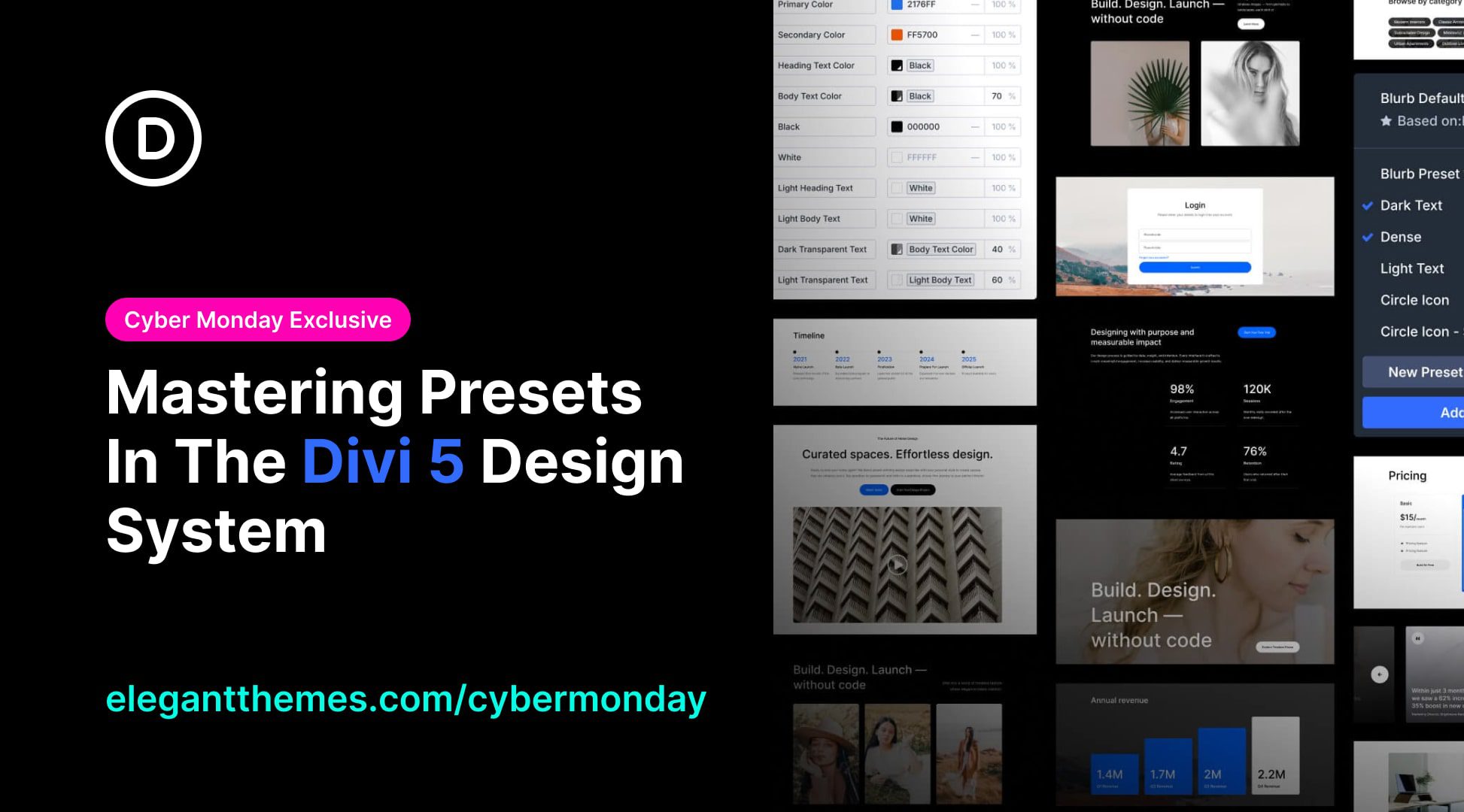Welcome to part 1 of 5 of our series Organizing and Taking Control of your Divi Web Design Business. In this series, we’re exploring several tactics, tools and strategies that will help you overcome the daily struggles that we all face as Divi Web Designers. From optimizing your daily routines, to creating systems and processes, to providing the best web design experience for your clients; we’re providing actionable items and steps that you can implement immediately with the purpose of helping you take control of your Divi Web Design business whether you’re a solo freelancer, a small agency or a remote team.
Taking control of your business starts with taking control of your time. And a great way to take control of your time is to create daily and weekly routines to ensure that YOU are running your business and that your business isn’t running you. In this post, we’ll explore some practical, actionable routines that you can apply to your daily and weekly web design work schedule!
Before diving in, here’s a quick snapshot of this series so you can know what to expect:
- Creating Efficient Routines for your Divi Web Design Business
- Organization Tactics and Practices for your Divi Web Design Business
- Effective Client Onboarding processes for Your Divi Web Design Business
- Refining and Standardizing your Divi Design and Development Process
- How to Effectively Manage Multiple Divi Web Design Projects
Though this series is directed to Divi Web Designers, you can apply many of these tactics and practices to any sort of web design business and any type of work for that matter. Ok, now that you know what to expect and are prepared for the rest of the series, let’s dive in!
Creating Efficient Routines for your Divi Web Design Business
To start, I’m going to share with you two major practices that have drastically helped me in maintaining and taking control of my Divi Web Design business:
Daily Routines and Weekly Routines
In my 6 1/2 years so far of freelance website design, implementing these 2 practices have helped me stay fresh and creative while juggling the administrative and monotonous duties of web design and running a business. Now this may look different depending on your situation – i.e. whether you work from home or at an agency, whether you’re single or have a family and children, whether you’re a solo freelancer or work with a team, etc. But regardless of your situation, it’s important to set routines that work for you to help keep you organized.

1) Implementing A Daily Routine and Schedule for your Divi Web Design Business
During the day to day activities of running a Divi web design business, you’re going to juggle many positions. You’ll be the salesman, IT, support, creative director, HR and yes if you’re working from home, even the janitor 🙂 Setting disciplined daily routines and practices can help you stay on track while juggling the responsibilities of all these roles.
What’s really helped me stay in control of my business is setting parameters in my day. For example; to start the day, I generally don’t look at my phone or a screen in the first half hour. I typically get up, make coffee and read a “real” book or sit outside and just give my mind some time to warm up before taking on the stresses of the day. Some may call this time “priming” or some sort of meditation. Whatever name you choose to give it, it’s a time to organize your thoughts, plan out your day and decide how YOU’RE going to run it before it starts running you. After that, I can getting started on my work and I know what my major goals are for the day.
When it comes to starting the day, you must do what works for you. Some bloggers feel more creative in the morning and like to write first thing. Some designers like to start designing immediately before doing any admin work. And some developers like to take care of any support inquiries before getting to anything else. Personally, I like to get to my email at the start of my work day and clear out as many as possible to help free me up to start my creative work. I take care of the emails that are most urgent and reach out to clients whose projects I may be working on currently, then I can move on to designing and developing.
Here’s an integral part of my daily routine – I generally break my day into 3 or 4 main segments and only work on 2 or 3 projects at most with email/administrative work and quick updates in between those segments. And perhaps the most important daily routine I’ve added recently is allowing at least one hour a day for “reactionary” work. With my Divi Web Design business In Transit Studios, I offer website maintenance, web hosting and SEO services which means I’ve opened myself up to some support roles, so I can’t just turn my email off all day. I am very intentional about having creative time and space but also allowing time in the day to take care of my monthly retainer client issues when they arise.
Before being intentional about this “reactionary work time,” I found myself completely caught off guard when clients had issues. I’d have to break free from a project to handle an issue and it would throw my creativity completely off. Depending on the urgency or situation of course I’ll handle an emergency right away but I’ve found most issues can wait until I get around to them in my reactionary time which is generally in the afternoon. It’s allowed me to focus on my work and if I happen to see an email with a website update or quick fix, I know I’ll be able to get to it shortly and I’ll still look like a rock star for my client. And if there isn’t anything I need to handle in my allotted reactionary time…then there’s some extra time I can spend on a project or an ET blog post 🙂
So, here’s what a typical web design day looks like for me:
- 8:30a-9:30a (After my morning warm up time and planning out what I want to accomplish in the day) Engage with some awesome Divi people in my Divi Web Designers group. Answer as many emails as possible pertaining to current ongoing projects and take care of any urgent administrative work.
- 9:30a-11:30a Project One
- 11:30a-12:30p Emailing round 2, scheduled calls and quick work/additions or updates and any invoicing or administrative work.
- 1p-3p Project Two
- 3p-4p Reactionary work time
- 4p-5p Email wrap ups, quick updates, time in my Divi Web Designers group, etc.
Now of course not every day looks like this. There are meetings, calls and many other things that come into play on a day to day basis. But things can quickly get out of hand if you don’t have a daily routine that YOU set and stick with. This daily routine has helped me manage and balance my business to a very effective level and has not only helped me stay on top of my projects but also to stay fresh for my creative and problem-solving work. So now that we have a good idea of setting up a productive daily routine, the next is…yep you guessed it, a weekly routine!

2) Implementing A Weekly Routine and Schedule for your Divi Web Design Business
I have one weekly meeting every Friday morning with my networking group (which is where nearly 50% of my leads and referrals come from) so I rarely miss that one. The rest of my week is open but can quickly get booked up if I’m not careful and if I let my clients dictate my schedule. For years my meetings were sporadic and booked randomly. Not so anymore. Now I generally schedule all my other meetings and calls on Tuesdays, Wednesdays and Thursdays and rarely more than 2 days in a week. There are numerous reasons for this.
First off, in my experience, Monday’s are generally not great days for website meetings. I’ve found that clients are just getting going with their week and are distracted by THEIR tasks and to do’s which make for some difficulties for a web developer planning out a website strategy, getting feedback, etc. And on the flip side, at the tail end of the week, Friday’s have proven to be fairly unproductive meeting days as well. This is probably a bit more obvious because at the end of the week most people are planning the weekend and are generally checked out by early afternoon. So I keep all my in-person meetings and most calls to the middle days of the week.
One very important lesson I’ve learned when it comes to in-person meetings is to group them together if possible. A one hour meeting, let’s say a half hour away, is roughly a 3-4 hour commitment. Here’s why; think of everything that goes into the time before and after the actual meeting. If you set a meeting at 10a and you have to leave at say 9:30a, you’re more than likely preparing your materials between 9a and the time you leave. If the meeting lasts an hour or so, that puts you at roughly 11a. Take account the drive back and the time it takes to decompress from the meeting and get back into the swing of your tasks. Now it’s closer to noon. Oh and then it’s lunch time. So what sounds like a “short” meeting can turn very quickly to a half day ordeal.
Now if you compile several meetings a week, you can see how 3 or 4 “quick” meetings can take up your whole week and leave you little time for your creative and productive work. So I’ve learned to group them together if possible. I’ll generally try to schedule meetings early if possible and layer them up. So I may have a meeting at 9a with one client, then 10:30a or 11a with another nearby. This allows me to do both meetings and have at least half a day left for my projects and daily routine stated above.
Some final quick tips on maximizing your daily and weekly routines:
- When setting up a meeting or a call, be specific. Give the client some options to choose from that work for you. For example: don’t ask a potential client “Are you available to meet next week?” Instead ask, “Are you available Tuesday at 9a or 2p or Thursday at noon?” This practice can save you hours of back and forth emails and wasted time trying to find out a time that works for the both of you. Provide 2 or 3 times that work for YOU and see if one of those options happens to work for your client or colleague.
- When grouping meetings together, be sure not to group them too close together in time or too far apart in distance. Make sure you give yourself a window for travel, cognitive decompression, etc. You don’t want to leave one meeting and head into another with the first meeting too much on your mind. You also don’t want to have to rush around and find yourself in a stressful window of time trying to get from one meeting to another if they’re far apart.
- When coming up with a daily routine that works for you, make sure it is realistic, attainable and flexible depending on your situation. If things come up and my day doesn’t line up exactly like I planned it, it’s ok – I’ll often reallocate the work that I missed to the next day in my open segments. I’ve found if I stick to a daily routine and focus on one or two projects and have some reactionary work time, it’s amazing what I can get done and can catch up on if I missed any to do’s from the day before.
In Closing
Well I hope the daily and weekly routines that I’ve implemented in my business have helped inspire you to set some routines in your web design schedules! Again these are practices that have worked for me in my solo, work from home business but it may vary depending on your situation. So do what works for you! Do you have any daily or weekly routines that have helped you and your Divi Web Design business? If so, feel free to mention those in the comments below and let us know if these ideas have helped or inspired you!
Coming up tomorrow: Organization Tactics and Practices for your Divi Web Design Business

Organization is the key to your success with any business. Once you have control of your time with daily and weekly routines that work for you, it’s time to focus on organizing the technology and tools you use on a daily basis. We’re going to explore some practical ways to help you stay organized so you can take better control of your Divi Web Design business. Till then!
Be sure to subscribe to our email newsletter and YouTube channel so that you never miss a big announcement, useful tip, or Divi freebie!













Hi Josh,
It is really a great article and also more helpful too. I have learned list of valuable information about web designing from your wonderful blog. Thanks for sharing a nice article.
Thanks so much for your awesome feedback, Finn! So glad this series has helped you out.
Hey, Josh, been looking forward to this series, I opened the tab for this one and was sitting down to read them all. I would be great if there were some cross-posting links so I could at least go straight to day 2, etc.
Hey Nate, yea unfortunately when I send the posts in for approval, they’re not live so I have nothing to actually link back to. But I’ll have these all linked back (by series) on my site this week if you want to check there for your reference. Hope that helps!
Great post Josh. I have seen that support issues can take over and destroy your daily goals, so the idea of actually setting up a daily hour for that is what I have to do. Thanks.
Great to hear you’re able to take that idea and implement it to your business, Erik! I love hearing when people are able to take away something actionable and apply it immediately. Thanks for your comment!
i didn’t know about this technicue, thanks 🙂
Thanks for your feedback, Saba! Hope these ideas are of some good use to you.
Great article Josh. Some very useful and practical advice there! Can’t wait for your next ones. One quick question I have for yourself, and everyone really, is what advice would you give someone starting out as a divi freelance web designer? I currently have 5 previous customers and testimonials but I am finding it difficult to generate new leads. Is there any advice you can give me with the experiences you have had?
Hey Callum, thanks for your feedback! I’m not sure if you saw the previous series about getting started as a Divi Web Designer, but I lay out some ideas in this post that may help:
http://www.elegantthemes.com/blog/divi-resources/how-to-start-getting-clients-for-your-divi-web-design-business
The majority of my leads come from my networking group and personal network that I’ve worked hard at building over the last 6 years. I’ve found that face to face relationships and connections go the farthest and if you do a good job and ASK for referrals, they’ll start coming in!
I haven’t seen that article yet, but thanks for linking it to me I shall make sure I shall check it out. Thanks very much for the advice it has helped a lot!
Great post Josh. We are on the process on learning number 3 and 5. As of the moment we are more on nuumber 4 Refining and Standardizing Divi Design and Development Process. 🙂
Great to hear! Hope the rest of the series will be a good inspiration and will hopefully give you some ideas you can implement!
Well said Josh 🙂
Regards
Michael
Thanks, Michael!
Great article. Thanks for sharing Josh. It is just what I need.
Awesome to hear, Maria. Thanks for your feedback!
Great post, Josh! Well stated and very clear. Love it! 🙂
Thanks, Jake!
Elegant Themes I love you so much! Thanks for the incoming series, keep up the good work 😀
Thanks, David!
Thanks Josh, I really enjoyed the article. I am on the same page with the weekly routine 2 days out maximum, 3 days in minimum but your daily tips are great as I am always dealing with reactionary issues and had never thought about leaving a free hour in the plan.
Thanks, Matt! That’s great to hear. Yea I think you’ll find that if you leave a little window of time each day for that reactionary work, you’ll be able to better manage all the incoming issues and little fixes that tend to pile up!
Hi Josh, Thanks for the tips. I purchased a planning calendar that allows me to schedule my entire day. It doesn’t always work out though since things come up. I like the idea of scheduling reactionary time. You are right, there is always something that comes up. I look forward to your other tips.
Thanks Terri! Yea having a planning calendar like that is a great idea. I’ve found that allowing some time each day for reactionary work has been huge in keeping me on track with my projects. Thanks for your feedback!
A well thought through article Josh with some great tips that I will be incorporating into my daily and weekly routine.
Interestingly you also point out that it is important to consider the routine of the people that one is working with in order to achieve productive meetings and collaborations resulting in more efficient time management.
Thanks Ray! That’s awesome to hear you’ll be able to incorporate some of these ideas into your schedule! Really makes the time that goes into these posts worth while knowing that the community is able to act on them.
Yea I’ve found it’s a thin line between working with others’ schedules but not letting them dictate yours. Offering a few meeting or call times is the best way I’ve found to manage my time and my client meetings.
Thanks again for your comment!
Thank you josh, I am looking forward to know the continuation of this series.
Thanks for the feedback, Thierry!
Great post Josh! i look forward to the rest of this series.
You mention a Friday morning networking group – is this a group you have set up?
Thanks, Gary! My networking group is actually just one chapter of a national networking organization. There are several chapters all around my city. You can find out more about it at phoenixchaptergc.com if you’d like. I put that site together for us recently 🙂
It’s great because there are several categories of businesses represented and is where many of my leads come from. I’m trusted as the “website guy” and I’ve found if you can get into a networking group like that, it goes a long way!
If you go to a city in a sports club – a good idea is to schedule appointments 1 hour before training. But talking about it to customers – not necessarily … 🙂
Having a full time job in addition to working as a freelance designer outside of business hours really highlights the importance of having a routine and sticking to it. I regularly opt for a night on the couch instead of working on my side business! I just joined Habitica, thanks to Ryan for the heads up! Looks like it’ll really help cement some great habits and help me finish my to do list. And thanks Josh for some helpful ideas for daily and weekly routines!
That’s great to hear, Jen! Yes if you’re doing freelance work on the side, it’s even MORE important to try to have a routine to stick to. Otherwise it’s easy to get distracted or push things aside like you said. Just a heads up, the rest of the series has some strategies and tools that I think will really help you out!
Thanks for your feedback on the post!
I’ll definitely keep an eye out for the rest of the blog posts in the series. Looking forward to reading them. Thanks again!
Would you mind sharing what tools you use to gather information at a meeting? I am currently still using a pen and paper and wonder if I am missing the boat on some valuable use of tech such as the new iPad with the pen for sketching ideas and note taking then making it easier to transfer those ideas to my desktop once I am back at my home office.
What about framework tools? What processes or apps could you suggest that help put together initial design ideas for the client to review before actually getting into the programming side of the site aside from using Photoshop which is very time consuming from what I can see in layout.
I would welcome your mentorship in these areas.
Thanks,
Adam
Hey Adam – we actually cover this in a couple posts coming up in this series! When it comes to initially meeting with clients, I’m actually doing it the same way you do – using a notepad and sometime’s I’ll make notes or save bookmarks on my laptop if I need to look back through examples or sites they like.
I know there are tons of tech tools you can use like you say but I like to be able to jot down notes quickly on paper if possible. And I’ve found that it’s more conversational for the client for me to have pen and paper than to have a screen in front of my in a meeting 🙂
Working from home takes a lot of discipline. Thanks for these tips in reclaiming my time. I’m looking forward to the rest of the series.
You’re totally right, Barbara – it does take extreme self discipline and I’ve found that any organization tips and tricks help! Thanks for your feedback!
Thanks Josh, this series is definitely for me, I need some structure in my WebDesign Work and not let the clients dictate my day…
AWESOME to hear, Daniel! Yea hopefully this series is a good resource of ideas that’ll help you and your business out!
Great help will try it.
Thanks Francisco. Hope these ideas help you out!
Good points Josh. Thanks for sharing. Have you ever tried the app Habitica? It’s a fun way that I stay on top of things.
Thanks, Ryan! Haven’t heard about that one but it looks pretty cool. Neat idea to incorporate achievement awards and the cool animated features. In part 5, we talk about some project management tools that are similar. Thanks for your feedback and comment!
Thanks Josh for your great post. I am having the same issues as you described. Running around as a headless chicken. From tomorrow on I am going go try it your way!
haha thanks for your feedback, Mathijn! Yep it can certainly feel like that sometimes. Glad this post was of some inspiration to you!
Josh, you’re a good example to follow. You bring up a good point about pinpointing the time for a client meeting. One question I have, and you’re probably going to address it in your next post 🙂 How do you keep track of the different ideas the client talks about at different meetings.
Looking forward to your next article.
Thanks, Joan! That’s a great question. I have a nice notebook that I use in every in-person meeting and generally before I meet with a potential client, I have them fill out my website questionnaire. Between that and what I pick up from them in the questionnaire, that provides most of the ideas I need to get the ball rolling.
I usually print that out and have everything in a client folder that I hold on to until the project is done. If the client has any links or examples they show me, I set up a bookmark for them with all the links they sent for my reference. I talk a little more about that in the next post.
Great question. I hope that helps!